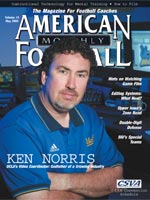AMERICAN FOOTBALL MONTHLY THE #1 RESOURCE FOR FOOTBALL COACHES
Article CategoriesAFM Magazine
|
So You Want to be a Video CoordinatorUCLA\'s Ken Norris on the position© More from this issue ďThere arenít too many positions available-there are 117 in Division I, 32 in NFL, and thatís it. (Smaller) schools usually donít have enough money. Itís an extremely important position, but youíve got to provide a decent product. Some schools provide terrible video. ďThere are chances to get into a job like this, but itís tough to crack into (the business). You canít go to school to be a video coordinator. I was lucky to know (former UCLA film coordinator) Stan Troutman who was in this position for 43 years, and have these planets line up and align. ďYou have to be really bad to be fired from this job, so itís very hard to lose this job. But you have to have a lot of patience because coaches will undoubtedly have a bad day and want to yell. I donít get i....The full article can only be seen by subscribers. Subscribe today!
|
|
|||||||
| HOME |
MAGAZINE |
SUBSCRIBE | ONLINE COLUMNISTS | COACHING VIDEOS |
Copyright 2025, AmericanFootballMonthly.com
All Rights Reserved





